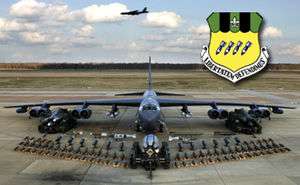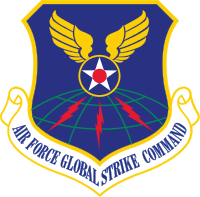Eighth Air Force
| Eighth Air Force | |
|---|---|
|
B-2A Spirit, 82-1069, "Spirit of Indiana", 509th Bomb Wing
B-52H Stratofortress, 2d Bomb Wing | |
| Active | 19 January 1942 – present |
| Country |
|
| Branch |
|
| Part of |
|
| Garrison/HQ | Barksdale Air Force Base, Louisiana |
| Nickname(s) | "The Mighty Eighth"[1] |
| Engagements |
|
| Decorations |
|
| Commanders | |
| Current commander | Maj Gen Thomas A. Bussiere |
| Notable commanders |
James Doolittle Ira C. Eaker Carl Spaatz |
| Insignia | |
| Emblem of the Eighth Air Force |
 |
The Eighth Air Force (8 AF) is a numbered air force (NAF) of the United States Air Force Global Strike Command (AFGSC). It is headquartered at Barksdale Air Force Base, Louisiana. The command serves as Air Forces Strategic – Global Strike, one of the air components of United States Strategic Command (USSTRATCOM). The Eighth Air Force includes the heart of America's heavy bomber force: the B-2 Spirit stealth bomber, the B-1 Lancer supersonic bomber, and the B-52 Stratofortress heavy bomber aircraft.
Established on 22 February 1944 by the redesignation of VIII Bomber Command at RAF Daws Hill in High Wycombe, England, 8 AF was a United States Army Air Forces combat air force in the European Theater of World War II, engaging in operations primarily in the Northern Europe AOR; carrying out strategic bombing of enemy targets in France, the Low countries, and Germany;[2] and engaging in air-to-air fighter combat against enemy aircraft until the German capitulation in May 1945. It was the largest of the deployed combat Army Air Forces in numbers of personnel, aircraft, and equipment.
During the Cold War, 8 AF was one of three Numbered Air Forces of the United States Air Force's Strategic Air Command (SAC), with a three-star general headquartered at Westover AFB, Massachusetts commanding USAF strategic bombers and missiles on a global scale. Elements of 8 AF engaged in combat operations during the Korean War; Vietnam War, as well as Operation Desert Storm.
Overview
Eighth Air Force is one of two active duty numbered air forces in Air Force Global Strike Command. Eighth Air Force, with headquarters at Barksdale AFB, in the Bossier City – Shreveport, Louisiana, metro area, supports U.S. Joint Forces Command, and is designated as U.S. Strategic Command's Task Force 204, providing on-alert, combat-ready forces to the president. The mission of "The Mighty Eighth" is to safeguard America's interests through strategic deterrence and global combat power. Eighth Air Force controls long-range nuclear-capable bomber assets throughout the United States and overseas locations. Its flexible, conventional and nuclear deterrence mission provides the capability to deploy forces and engage enemy threats from home station or forward positioned, anywhere, any time. The 8th Air Force motto is "Peace Through Strength."
The Eighth Air Force team consists of more than 16,000 active-duty, Air National Guard and Reserve professionals operating and maintaining a variety of aircraft capable of deploying air power to any area of the world. This air power includes the heart of America's heavy bomber force: the B-2 Spirit and the B-52 Stratofortress. The Mighty Eighth's B-52 force consists of 76 bombers assigned to two active duty wings, the 2d Bomb Wing at Barksdale AFB, Louisiana and the 5th Bomb Wing at Minot AFB, North Dakota, and one reserve wing, the 307th Bomb Wing at Barksdale AFB, Louisiana. The B-2 force consists of 20 bombers assigned to the 509th Bomb Wing at Whiteman AFB, Missouri.[3]
Major General Thomas A. Bussiere was named Commander on October 4, 2016 after having served as the Deputy Director, for Nuclear, Homeland Defense, and Current Operations, Joint Staff, the Pentagon, Washington, D.C.
History
- For additional history and lineage, see United States Air Forces in Europe
The history of Eighth Air Force begins on 2 January 1942 with its activation at Savannah Air Base, Georgia. In quick order, on 5 January, Major General Carl Spaatz assumed command of HQ Eighth Air Force at Bolling Field, Washington, DC. On 8 January the order activating the "U.S. Air Forces in the British Isles" (USAFBI) was announced. On 12 May, the first contingent of USAAF personnel arrived in England to join the Eighth Air Force. On 15 June, Spaatz arrived in England to establish the Headquarters of Eighth Air Force at Bushy Park, 15 miles (24 km) WSW of London.[4]
Eighth Air Force was the command and control organization over its operational components:
- VIII Bomber Command (Established 19 January 1942)
- Strategic bombardment using heavy, 4-engined bombers.
- VIII Fighter Command (Established 19 January 1942)
- Provide fighter escort of heavy bombers
- VIII Air Support Command (Established 24 April 1942)
- Provide reconnaissance, troop transport, and tactical bombardment using twin-engine medium bombers.
- VIII Air Service Command (later VIII Air Force Service Command)
- Service and logistical support.
VIII Bomber Command was activated at Langley Field, Virginia, It was reassigned to Savannah Air Base, Georgia on 10 February 1942. An advanced detachment of VIII Bomber Command was established at RAF Bomber Command Headquarters at RAF Daws Hill England on 23 February in preparation for its units to arrive in the United Kingdom from the United States. The first combat group of VIII Bomber Command to arrive in the United Kingdom was the ground echelon of the 97th Bombardment Group, which arrived at RAF Polebrook on 9 June 1942.
Regular combat operations by the VIII Bomber Command began on 17 August 1942, when the 97th Bombardment Group flew 12 B-17Es on the first VIII Bomber Command heavy bomber mission of the war from RAF Polebrook, attacking the Rouen-Sotteville marshalling yards in France.

During World War II, the offensive air forces of the United States Army Air Forces (USAAF) came to be classified as strategic or tactical. A strategic air force was that with a mission to attack an enemy's war effort beyond his front-line forces, predominantly production and supply facilities, whereas a tactical air force supported ground campaigns, usually with objectives selected through co-operation with the armies.
In Europe, Eighth Air Force was the first USAAF strategic air force, with a mission to support an invasion of continental Europe from the British Isles. Eighth Air Force carried out strategic daytime strategic bombing operations in Western Europe from airfields in eastern England.
World War II (1944–1945)
.png)
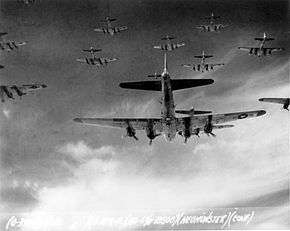
|
|
On 4 January 1944, the B-24s and B-17s based in England flew their last mission as a subordinate part of VIII Bomber Command. On 22 February 1944, a massive reorganization of American airpower took place in Europe. VIII Bomber Command and Ninth Air Force were brought under control of a centralized headquarters for command and control of the United States Army Air Forces in Europe, the United States Strategic Air Forces (USSTAF).
VIII Bomber Command was redesignated as Eighth Air Force, with VIII Fighter and VIII Air Support Commands being brought under the command of the redesignated Eighth Air Force. This is from where the present-day Eighth Air Force's history, lineage and honors derive.
General Carl Spaatz returned to England to command the USSTAF. Major General Jimmy Doolittle relinquished command of the Fifteenth Air Force to Major General Nathan F. Twining and took over command of the Eighth Air Force from Lieutenant General Ira C. Eaker at RAF High Wycombe. Doolittle of course was well known to American airmen as the famous "Tokyo Raider" and former air racer. His directive was simple: 'Win the air war and isolate the battlefield'.
Spaatz and Doolittle's plan was to use the US Strategic Air Forces in a series of co-ordinated raids, code-named Operation 'Argument' and supported by RAF night bombing, on the German aircraft industry at the earliest possible date.
Big Week
Cold and clear weather was predicted for the last week of February 1944 and Operation Argument became known as "Big Week". On the night of 19–20 February, the RAF bombed Leipzig. Eighth Air Force put up over 1,000 B-17s and B-24s and over 800 fighters and the RAF provided sixteen squadrons of Mustangs and Spitfires. In all, twelve aircraft factories were attacked, with the B-17s heading to Leipzig (Allgemeine Transportanlagen-Gesellschaft - Junkers Ju 88 production and Erla Maschinenwerk - Bf 109), Bernburg-Strenzfeld (Junkers Ju 88 plant) and Oschersleben (AGO plant making Focke-Wulf Fw 190A fighters), while the B-24s hitting the Gothaer Waggonfabrik (production of Messerschmitt Bf 110), the Fw 190 Arado plant at Tutow and the Heinkel firm's "Heinkel-Nord" headquarters at Rostock (production of He 111). The raids on the German aircraft industry comprising much of "Big Week" caused so much damage that the Germans were forced to disperse aircraft manufacturing eastward, to safer parts of the Reich.
The next day, over 900 bombers and 700 fighters of Eighth Air Force hit more aircraft factories in the Braunschweig area. Over 60 Luftwaffe fighters were shot down with a loss of 19 US bombers and 5 US fighters. On 24 February, with the weather clearing over central Germany, Eighth Air Force sent over 800 bombers, hitting Schweinfurt and attacks on the Baltic coast, with a total of 11 B-17s being lost. Some 230 B-24s hit the Messerschmitt Bf 110 assembly plant at Gotha with a loss of 24 aircraft.
On 25 February, both Eighth and Fifteenth Air Forces hit numerous targets at Fürth airfield, Augsburg and Regensburg, attacking Messerschmitt Bf 110 and Bf 109 plants. The 8th lost 31 bombers, the 15th lost 33.
Berlin
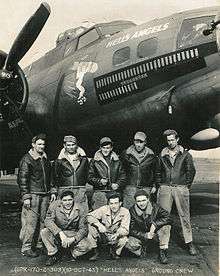
Less than a week after "Big Week", Eighth Air Force made its first attack on the Reich's capital, Berlin. The RAF had been making night raids on Berlin since 1940, (with heavy raids in 1943) and nuisance Mosquito raids in daylight, but this was the first major daylight bombing raid on the German capital. On 6 March 1944, over 700 heavy bombers along with 800 escort fighters of the Eighth Air Force hit numerous targets within Berlin, dropping the first American bombs on the capital of the Third Reich. On 8 March, another raid of 600 bombers and 200 fighters hit the Berlin area again, destroying the VKF ball-bearing plant at Erkner. The following day, on 9 March, H2X radar-equipped B-17s mounted a third attack on the Reich capital through clouds. Altogether, the Eighth Air Force dropped over 4,800 tons of high explosive on Berlin during the first week of March.
On 22 March, over 800 bombers, led by H2X radar equipped bombers hit Berlin yet again, bombing targets though a thick rainy overcast causing more destruction to various industries. Because of the thick clouds and rain over the area the Luftwaffe did not attack the American bomber fleet, as the Germans believed that because of the weather the American bombers would be incapable of attacking their targets. However, the "pathfinder" bombers of the RAF Alconbury-based 482d Bomb Group proved very capable of finding the targets and guiding the bombers to them.
Prelude to Overlord
In a prelude to the invasion of France, American air attacks began in February 1944 against railroad junctions, airfields, ports and bridges in northern France and along the English Channel coastline. Fighters from both Eighth and Ninth Air Forces made wide sweeps over the area, mounting strafing missions at airfields and rail networks. By 6 June, Allied fighter pilots had succeeded in damaging or destroying hundreds of locomotives, thousands of motorized vehicles, and many bridges. In addition, German airfields in France and Belgium were attacked.
On 1 May, over 1,300 Eighth Air Force heavy bombers made an all-out attack on the enemy's rail network, striking at targets in France and Belgium. On 7 May, another 1,000 bombers hit additional targets along the English Channel coast, hitting fortifications, bridges and marshaling areas.
On D-Day, over 2,300 sorties were flown by Eighth Air Force heavy bombers in the Normandy and Cherbourg invasion areas, all aimed at neutralizing enemy coastal defenses and front-line troops.
Defeat of the Luftwaffe
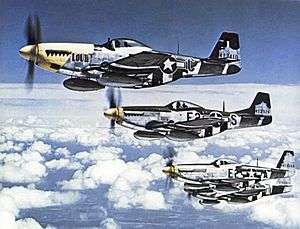
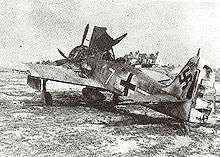
The P-51 Mustang first entered squadron service in Europe with the British in early 1942; the Allison V-1710 engined P-51A (Mustang I) having much success with the RAF, although it found the aircraft's performance inadequate at higher altitudes. Rolls-Royce engineers rapidly realized that equipping the Mustang with a Rolls-Royce Merlin engine with its two speed, two stage supercharger would substantially improve performance. Also, by using a four-bladed propeller, rather than the three-bladed one used on the P-51A, the performance was greatly improved; the XP-51B achieved a level speed of 441 mph at 29,800 feet (9,100 m), over 100 mph faster than the Allison-engined P-51A at that altitude. At all heights, the rate of climb was approximately doubled.
The USAAF now finally had an aircraft that could compete on equal terms with the Focke-Wulf Fw 190 and the later models of the Messerschmitt Bf 109. The USAAF was finally fully sold on the Mustang, and a letter contract for 2200 P-51Bs was issued. The engine was to be the Packard V-1650-3, based on the Merlin 68.
In late 1943, the P-51B Mustang was introduced to the European Theater by the USAAF. It could fly as far on its internal fuel tanks as the P-47 could with drop tanks. However, the P-51B was introduced as a tactical fighter, so the first deliveries of the P-51B in November 1943 were assigned to three groups in the tactical Ninth Air Force at the expense of VIII Bomber Command, whose need for a long range escort fighter was critical. The first escort mission for the bombers was not flown until 5 December.
As the new commander of the Eighth Air Force from January 1944 onwards, Major General Jimmy Doolittle's major influence on the European air war occurred early that year when he made a critical change to the policy requiring escorting fighters to remain with the bombers at all times. With his permission, initially performed with P-38s and P-47s with both previous types being steadily replaced with the long-ranged P-51s as the spring of 1944 wore on, American fighter pilots on bomber defense missions would primarily be flying far ahead of the bombers' combat box formations in air supremacy mode, literally "clearing the skies" of any Luftwaffe fighter opposition heading towards the target. This strategy fatally disabled the twin-engined Zerstörergeschwader heavy fighter wings and their replacement, single-engined Sturmgruppen of heavily armed Fw 190As, clearing each force of bomber destroyers in their turn from Germany's skies throughout most of 1944. As part of this game-changing strategy, especially after the bombers had hit their targets, the USAAF's fighters were then free to strafe German airfields and transport while returning to base, contributing significantly to the achievement of air superiority by Allied air forces over Europe.
The effect of the Mustangs, fully operating as an air supremacy fighter force, on the Luftwaffe defenders was arguably swift and decisive. The result was that the Luftwaffe was notable by its absence over the skies of Europe after D-Day and the Allies were starting to achieve air superiority over the continent. Although the Luftwaffe could, and did, mount effective attacks on the ever larger formations of Allied heavy bombers, the sheer numbers of B-17s and B-24s attacking enemy targets was overwhelming the German fighter force, which simply could not sustain the losses the Eighth Air Force bombers and fighters were inflicting on it.
By mid-1944, Eighth Air Force had reached a total strength of more than 200,000 people (it is estimated that more than 350,000 Americans served in Eighth Air Force during the war in Europe). At peak strength, Eighth Air Force had forty heavy bomber groups, fifteen fighter groups, and four specialized support groups. It could, and often did, dispatch more than 2,000 four-engine bombers and more than 1,000 fighters on a single mission to multiple targets.
By 1945, all but one of the Eighth Air Force fighter groups were equipped with the P-51D.
Destroying the German oil industry
Eighth Air Force did not strike at oil industry targets until 13 May 1944 when 749 bombers, escorted by almost 740 fighters, pounded oil targets in the Leipzig area and at Brux in Czechoslovakia. At the same time, a smaller force hit an FW 190 repair depot at Zwickau. Over 300 German fighters attacked the bomber forces, losing almost half its aircraft, with claims of upwards of 47 Luftwaffe fighters by American fighter pilots. However, the Luftwaffe was successful in shooting down 46 bombers in a very unequal fight.[5]
After D-Day, attacks on the German oil industry assumed top priority which was widely dispersed around the Reich. Vast fleets of B-24s and B-17s escorted by P-51Ds and long-range P-38Ls hit refineries in Germany and Czechoslovakia in late 1944 and early 1945. Having almost total air superiority throughout the collapsing German Reich, Eighth Air Force hit targets as far east as Hungary, while Fifteenth Air Force hit oil industry facilities in Yugoslavia, Romania, and northeastern Italy. On at least eighteen occasions, the Merseburg refineries in Leuna, where the majority of Germany's synthetic fuel for jet aircraft was refined, was hit. By the end of 1944, only three out of ninety-one refineries in the Reich were still working normally, twenty-nine were partially functional, and the remainder were completely destroyed.
Casualties and awards
These missions, however, carried a high price. Half of the U.S. Army Air Force's casualties in World War II were suffered by Eighth Air Force (more than 47,000 casualties, with more than 26,000 dead). Seventeen Medals of Honor went to Eighth Air Force personnel during the war. By war's end, they had been awarded a number of other medals to include 220 Distinguished Service Crosses, and 442,000 Air Medals. Many more awards were made to Eighth Air Force veterans after the war that remain uncounted. There were 261 fighter aces in the Eighth Air Force during World War II. Thirty-one of these aces had 15 or more aircraft kills apiece. Another 305 enlisted gunners were also recognized as aces.
Victory in Europe
In January 1945, the Luftwaffe attempted one last major air offensive against the Allied Air Forces. Over 950 fighters had been sent west from the Eastern Front for "Operation Bodenplatte". On 1 January, the entire German fighter force in the West, comprising combat aircraft from some eleven Jagdgeschwader day fighter wings, took off and attacked 27 Allied airfields in northern France, Belgium and the southern part of the Netherlands in an attempt by the Luftwaffe to cripple Allied air forces in the Low Countries of Europe. It was a last-ditch effort to keep up the momentum of the German Army (Wehrmacht Heer) during the stagnant stage of the Battle of the Bulge (Unternehmen Wacht am Rhein). The operation was a pyrrhic success for the Luftwaffe as the losses suffered by the German air arm were irreplaceable and over 300 Luftwaffe aircraft were shot down, mostly by Allied Anti-Aircraft guns. The losses of the Allied Air Forces were replaced within weeks. The operation failed to achieve air superiority, even temporarily, and the German Army continued to be exposed to air attack.
First seen by Allied airmen during the late summer of 1944, it wasn't until March 1945 that German jet aircraft started to attack Allied bomber formations in earnest. On 2 March, when Eighth Air Force bombers were dispatched to attack the synthetic oil refineries at Leipzig, Messerschmitt Me 262As attacked the formation near Dresden. The next day, the largest formation of German jets ever seen, most likely from the Luftwaffe's specialist 7th Fighter Wing, Jagdgeschwader 7 Nowotny, made attacks on Eighth Air Force bomber formations over Dresden and the oil targets at Essen, shooting down a total of three bombers.
However, the Luftwaffe jets were simply too few and too late to have any serious effect on the Allied air armadas now sweeping over the Reich with near-impunity. A lack of fuel and available pilots for the new jets greatly reduced their effectiveness. The Me 262A was a difficult foe for the P-47s and P-51s, possessing a distinct speed advantage. Allied bomber escort fighters would fly high above the bombers – diving from this height gave them extra speed, thus reducing the speed difference. The Me 262 was also less maneuverable than the P-51 and so trained Allied pilots could turn tighter than an Me 262A. However, the only reliable way of dealing with the jets, as with the even faster Me 163B Komet rocket fighters, was to attack them on the ground and during takeoff and landing. Luftwaffe airfields that were identified as jet and rocket bases, such as Parchim and Bad Zwischenahn, were frequently bombed, and Allied fighters patrolled over the fields to attack jets trying to land. The Luftwaffe countered by installing flak alleys along the approach lines in order to protect the Me 262s from the ground and providing top cover with conventional fighters during takeoff and landing. Nevertheless, in March and April 1945, Allied fighter patrol patterns over Me 262 airfields resulted in numerous losses of jets and serious attrition of the force.
On 7 April 1945, the Luftwaffe flew its most desperate and deadliest mission, with the dedicated aerial ramming unit Sonderkommando Elbe. This operation involved German pilots of the unit ramming their worn-out Bf 109Gs, each barely armed with only one MG 131 heavy machine gun and 50 rounds of ammunition, into American bombers in order to get the Allies to suspend bombing raids long enough for the Germans to make a significant amount of Me 262A jet fighters. The 8th Air Force was targeted in this operation. Fifteen Allied bombers were attacked, eight were successfully destroyed.
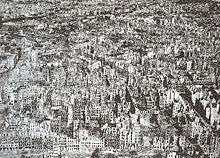
On 7 April, Eighth Air Force dispatched thirty-two B-17 and B-24 groups and fourteen Mustang groups (the sheer numbers of attacking Allied aircraft were so large in 1945 that they were now counted by the group) to targets in the small area of Germany still controlled by the Nazis, hitting the remaining airfields where the Luftwaffe jets were stationed. In addition, almost 300 German aircraft of all types were destroyed in strafing attacks. On 16 April, this record was broken when over 700 German aircraft were destroyed on the ground.
The end came on 25 April 1945 when Eighth Air Force flew its last full-scale mission of the European War. B-17s hit the Skoda armaments factory at Pilsen in Czechoslovakia, while B-24s bombed rail complexes surrounding Hitler's mountain retreat at Berchtesgaden.
Pacific Theater
Following the end of the war in Europe in May 1945 plans were made to transfer some of the B-17/B-24 heavy bomber groups of Eighth Air Force to the Pacific Theater of Operations and upgrade them to B-29 Superfortress Very Heavy (VH) bomb groups. As part of this plan, Eighth Air Force headquarters was reassigned to Sakugawa (Kadena Airfield), Okinawa, on 16 July 1945, being assigned to the United States Strategic Air Forces in the Pacific without personnel or equipment.[6]
On Okinawa, Eighth Air Force derived its headquarters personnel from the inactivated XX Bomber Command, and Lieutenant General James H. Doolittle assumed command, being reassigned from England on 19 July. The command controlled three airfields on Okinawa, Bolo, Futema, and Kadena Airfield. The Eighth received its first B-29 Superfortress on 8 August 1945.[6]
Eighth Air Force's mission in the Pacific was initially to organize and train new bomber groups for combat against Japan. In the planned invasion of Japan, the mission of Eighth Air Force would be to conduct B-29 Superfortress raids from Okinawa in coordination with Twentieth Air Force operating from airfields in the Mariana Islands.[6]
Units assigned to Eighth Air Force in the Pacific were:
|
|
The atomic bombings of Japan led to the Japanese surrender before Eighth Air Force saw action in the Pacific theater. Eighth Air Force remained in Okinawa until 7 June 1946.
Strategic Air Command


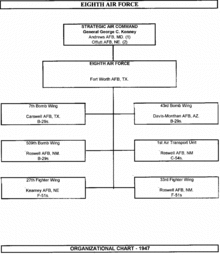
World War II proved what the proponents of air power had been championing for the previous two decades—the great value of strategic forces in bombing an enemy's industrial complex and of tactical forces in controlling the skies above a battlefield. As a result, Eighth Air Force was incorporated into the new Strategic Air Command (SAC).
On 7 June 1946, Headquarters Eighth Air Force was reassigned without personnel or equipment from Okinawa to MacDill AAF, Florida, becoming SAC's second numbered air force. At MacDill, Eighth Air Force headquarters were manned chiefly by personnel from the 58th Bombardment Wing, Very Heavy, stationed at Fort Worth AAF, Texas. The organization reported administratively to the Fifteenth Air Force at Colorado Springs, Colorado. That base assignment lasted until 1 November 1946, when SAC transferred the Eighth to Fort Worth (later renamed Carswell AFB).
Bomb units
Both Davis-Monthan and Fort Worth Army Airfields were B-29 training bases during World War II, and the Eighth Air Force Bomb Groups were simply activated at the same field and on the same day as the original Army Air Force Continental Air Forces training bomb groups were inactivated. The assets of the former training units were simply assigned to Eighth Air Force. This was largely so that the Air Force could perpetuate the names of groups that had distinguished themselves in World War II.
These bomb wings were drastically undermanned and under equipped. At the close of 1946, they shared only a handful of operational bombers, all B-29 Superfortresses. Although there were many available which were returned from Twentieth Air Force in the Pacific Theater they were war-weary from the many long combat missions flown during the war. However, it was believed that a strong strategic air arm equipped with B-29s would deter a possible aggressor from attacking the United States for fear of massive retaliation with nuclear weapons.
By the late 1940s, the B-17 Flying Fortresses and B-24 Liberators used in the European Theater of the war were thoroughly obsolete as combat aircraft and were mostly sent to the smelters. A handful remained in service performing non-combat duties though the mid-1950s as air-sea rescue aircraft (SB-17, SB-24); photo-reconnaissance aircraft (RB-17, RB-24), and as unmanned target drones (QB-17) and their controllers (DB-17).
Initially, Eighth Air Force under SAC consisted of the following:
- Fort Worth AAF (Later Carswell AFB), Texas
- 58th Bombardment Wing (later Air Division)
- Reassigned from March Field, California 8 May 1946
- Reassigned to Andrews AFB, Maryland 1 March 1948 (Inactivated 16 October 1948)
- 449th Bombardment Group
- Reassigned from McCook AAF, Nebraska December 1945 (McCook AAF Closed)
- Inactivated on 4 August 1946
- 7th Bombardment Group
- Activated on 1 October 1946
- 7th Bombardment Wing established on 17 November 1947. 7th Bomb Group assigned as subordinate unit.
Personnel and equipment from the inactivated 449th Bomb Group were reassigned to the 7th Bomb Group (later 7th Bomb Wing). The command staff and all personnel of the 58th Bomb wing were eliminated on 1 November 1946 and the organization was reduced to a paper unit. For two years, the wing remained in this status until the 58th Bomb Wing was inactivated on 16 October 1948.
- Davis-Monthan AAF (Later Davis-Monthan Air Force Base), Arizona
- 40th Bombardment Group
- Reassigned from March Field, California, 8 May 1946
- Inactivated on 1 October 1946
- 444th Bombardment Group
- Reassigned from Merced AAF, California 6 May 1945
- Inactivated on 1 October 1946
- 43rd Bombardment Group
- Activated on 4 October 1946
- 43d Bombardment Wing established on 3 November 1947. 43d Bomb Group assigned as subordinate unit.
Personnel and equipment from the inactivated 40th and 444th Bomb Groups were reassigned to the 43d Bomb Group
- Roswell AAF (Later Walker Air Force Base), Arizona
- 509th Bombardment Group
- Reassigned from North Field, Tinian on 8 November 1946
- 509th Bombardment Wing established on 3 November 1947. 509th Bombardment Group assigned as subordinate unit.
The Eighth Air Force was specifically charged with the atomic mission; however, only the 509th Composite Group at Roswell AAF had B-29s that had the capability to drop nuclear weapons - the 7th Bomb Group at Fort Worth AAF was modifying their aircraft to carry the atomic bomb.
- Smoky Hill AAF (Later Smoky Hill Air Force Base), Kansas Transferred from Fifteenth Air Force, 16 May 1948
- 301st Bombardment Wing
- Reassigned to Barksdale AFB, Louisiana, 1 August 1949. Smoky Hill AFB Inactivated.
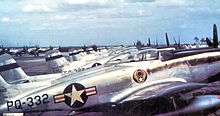

From 1946 through 1949, what little money became available was used to buy new planes (B-50 Superfortress, B-36 Peacemaker) for SAC, and as the newer aircraft became available, the older B-29s were sent to storage depots or sent to Air Force Reserve units for training missions.
Fighter units
SAC was founded by the men who fought in World War II, who knew the importance of fighter escorts. In its early days, SAC had fighter wings for the escorting its aircraft equipped with the new F-82E Twin Mustang along with long range F-51H Mustangs and F-47N Thunderbolts, all of which were designed late in World War II for use in the planned invasion of Japan. SAC fighter wings assigned to Eighth Air Force were:
- 27th Fighter Wing (F-82E Twin Mustang)
- Activated at Kearney AFB, Nebraska on 27 July 1947
- Reassigned to Bergstrom AFB, Texas on 16 March 1949 (Base Closed)
- 31st Fighter Wing (F-47N Thunderbolt)
- Activated at Turner AFB, Georgia on 25 June 1947
- Inactivated on 16 June 1952
- 33d Fighter Wing (F-51H Mustang, F-80C Shooting Star)
- Attached to 509th Bombardment Wing, Very Heavy, Walker AFB, New Mexico 17 November 1947
- Reassigned to Otis AFB, Massachusetts, 15 November 1948
- 82d Fighter Wing (F-51D Mustang)
- Activated at Grenier AFB, New Hampshire on 12 April 1947
- Inactivated 2 October 1949
Fighter escorts were no longer needed once SAC was equipped with Boeing B-47 Stratojet and then Boeing B-52 Stratofortress jet bombers carrying nuclear bombs. As the nuclear weapons carried by the bombers were so powerful that only one plane was assigned to a target that might have previously needed a whole bomb group of aircraft. Although SAC fighter squadrons upgraded to Republic F-84F Thunderstreak jet fighters in the early 1950s, the new jet bombers flew so high and so fast there was little danger of them being intercepted by enemy fighters. By 1955, SAC no longer needed its fighters and these fighter units were transferred to Tactical Air Command and utilized in a tactical role.
In 1949, a realignment of responsibilities for SAC's two air forces occurred. Fifteenth Air Force was relocated to March AFB, California. As part of this realignment, most SAC bomber forces west of the Mississippi River were reassigned to 15th AF. Those east of the Mississippi were assigned to SAC's other strategic air force, Eighth Air Force, which was reassigned to Westover AFB, Massachusetts, where it commanded all SAC bases in the eastern United States.
Several events in the late 1940s reversed the drawdown of United States strategic forces. The 1948 blockade of West Berlin by the Eastern bloc and the outbreak of the Cold War caused the United States to deploy SAC's B-29 bomber force back to the United Kingdom and West Germany. Communist victories in the Chinese Civil War in 1949 and the outbreak of the Korean War in 1950 meant that the United States would have to expand SAC to address these potential threats both in Europe as well as Asia.
By the time of the outbreak of the Korean War in June 1950, Eighth Air Force consisted of the following units:
|
|
Korean War
On 25 June 1950, the armed forces of the Democratic People's Republic of Korea (North Korea) invaded South Korea. On 27 June, the United Nations Security Council voted to assist the South Koreans in resisting the invasion. Although Eighth Air Force's strategic bomber force was not committed to combat in Korea, the Eighth deployed the 27th Fighter Escort Wing for combat action in Korea and earned numerous honors and awards for their combat record during the Korean War.
On 21 January 1951, Lt. Col. William Bertram, commander of the 523rd Fighter-Escort Squadron, shot down the first MiG-15 for the wing and became the first F-84 pilot with a confirmed MiG kill. Two days later, on 23 January, the 27th FEW participated in the raid on Sinuju Airfield in North Korea and shot down four more MiG-15s. By the time the group rotated back to the United States, they had flown more than 23,000 combat hours in more than 12,000 sorties.
For its Korean War service, the 27th Fighter-Escort Wing received the Distinguished Unit Citation, covering the period of 26 January through 21 April 1951, for their actions in Korea.
The 27th was relieved of its duties supporting U.N. forces in Korea and returned to Bergstrom AFB on 31 July 1951, but was redeployed to Misawa AB, Japan during 6 October 1952 – 13 February 1953 to provide air defense.
Cold War


With the end of fighting in Korea, President Dwight D. Eisenhower, who had taken office in January 1953, called for a "new look" at national defense. The result: a greater reliance on nuclear weapons and air power to deter war. His administration chose to invest in the Air Force, especially Strategic Air Command. The nuclear arms race shifted into high gear. The Air Force retired nearly all of its piston-engined B-29/B-50s and they were replaced by new Boeing B-47 Stratojet aircraft. By 1955 the Boeing B-52 Stratofortress would be entering the inventory in substantial numbers, as prop B-36s were phased out of heavy bombardment units rapidly.
Also after the deployment of forces to Far East Air Force to engage in combat over Korea, the history of Eighth Air Force becomes indistinguishable from that of Strategic Air Command. The Eighth's weapons inventory also changed to include KC-135 air refuelers and intercontinental ballistic missiles (the Atlas, Titan I and Titan II, and all Minuteman models.)
At the same time, aerial refueling techniques were improved to the extent that Eighth Air Force bombers could still reach targets in Europe and Asia even if overseas bases were destroyed by an enemy attack. To reduce the risk to its bomber fleet in the United States, Eighth Air Force aircraft stood nuclear alert, providing a deterrent against an attack on the United States by the Soviet Union. It dispersed its planes to a large number of bases across the United States so as not to have too many concentrated at a single location.
Vietnam War
In 1965, Eighth Air Force entered combat again, this time in Southeast Asia. At first, the Eighth deployed its B-52 bomber and KC-135 tanker units from the U.S. to operating bases in Guam, Okinawa and Thailand. Then in April 1970, SAC moved the Eighth without personnel or equipment to Andersen AFB Guam, absorbing resources of the 3d Air Division. At Anderson, the Eighth took over the direction of all bombing and refueling operations in Southeast Asia. The intensive bombing of Hanoi and Haiphong during 11 days in December 1972, known as Operation Linebacker II, was but one highlight of those war years. Importantly, the Eighth's bombing effectiveness influenced the North Vietnamese to end hostilities. With the end of combat in Southeast Asia, the Eighth Air Force moved without personnel or equipment to Barksdale AFB Louisiana on 1 January 1975, absorbing the resources of Second Air Force.
In the 1980s, the Eighth participated in several key operations such as running the tanker task force for Operation Urgent Fury in 1983 and directing all air refueling operations for Operation El Dorado Canyon in 1986 and Operation Just Cause in 1989.
Operations over Iraq
The Eighth's units played a key role in the 42-day Gulf War in 1991. An Eighth Air Force unit, the 2d Bomb Wing, spearheaded the air campaign by dispatching B-52s from Barksdale to launch conventional air-launched cruise missiles against Iraqi targets. Eighth Air Force bomb wings, stationed in the Persian Gulf region, also attacked Iraq's Republican Guard forces and numerous key strategic targets, while other units provided air refueling and tactical reconnaissance throughout the conflict. As a headquarters, the Eighth had another important role in victory over Iraqi forces—operating the logistics supply and air refueling bridge between the U.S. and gulf region.
History from June 1992

Fifteen months after Operation Desert Storm, the Air Force reorganized. Eighth Air Force was relieved from assignment to Strategic Air Command and assigned to the new Air Combat Command (ACC) on 1 June 1992.
Under ACC, Eighth Air Force provides command and control, intelligence, surveillance, and reconnaissance (C2ISR); long-range attack; and information operations forces to Air Force components and warfighting commands. Eighth Air Force trains, tests, exercises and demonstrates combat-ready forces for rapid employment worldwide.
Eighth Air Force also provides conventional forces to U.S. Joint Forces Command and provides nuclear capable bombers, specified Global Strike assets, and C2ISR capabilities to U.S. Strategic Command (STRATCOM). Eighth Air Force also supports STRATCOM's Joint Force Headquarters – Information Operations and serves as the command element for Air Force wide computer network operations.
Under ACC, the Eighth received control over active duty, Air Force Reserve, and Air National Guard units in the central U.S. and two overseas locations. Then in January 1994, ACC reorganized Eighth Air Force as a general purpose Numbered Air Force (NAF) with a warfighting mission to support the U.S. Joint Forces and U.S. Strategic Commands. Support to the latter command included the operation of Task Force 204 (bombers).
Since 1994, the Eighth has participated in a string of contingency operations, such as the 1996 Operation "Desert Strike" against Iraq, the 1998 Operation "Desert Fox" (similarly named but in no way associated with Field Marshal Erwin Rommel) against Iraq, which featured the B-1B in its combat debut, and 1999 Operation "Allied Force" against the Federal Republic of Yugoslavia, which involved the B-2A Spirit in its first uncontested mission of aggression, which was officially designated "combat". The "Allied Force" campaign also marked the Eighth's return to Europe and the participation of U.S. bombers in the North Atlantic Treaty Organization's (NATO) first combat operation. Altogether, the Eighth's bombers flew 325 sorties to drop over 7 million pounds of ordnance on a nation slightly smaller than the state of Colorado.
In 2000, the Air Force decided to integrate information operations into Eighth Air Force. The integration process started on 1 February 2001, when the Air Force realigned the Air Intelligence Agency (AIA) under ACC and assigned the 67th Information Operations Wing and the 70th Intelligence Wing to the Eighth. The reorganization transformed the Eighth into the only information operations and bomber NAF in the Air Force. For the Mighty Eighth, that change heralded an interesting future, one that bring further restructuring, different aircraft system purchases, and a new challenging mission to the NAF.
While posturing itself for that mission change, the Eighth also supported Operation "Enduring Freedom" in which the Air Force operates against targets in Afghanistan, and "NOBLE EAGLE" for the defense of North American airspace. Throughout the first six months of "ENDURING FREEDOM", the Mighty Eighth's bombers were instrumental in the eradication of many targets and opposing combatants in Afghanistan.
Global Strike Command
Under Air Force Global Strike Command since 1 Feb. 2010, Eighth Air Force controls strategic bomber (e.g., B-2 Spirit and B-52 Stratofortress, and B-1 Lancer) assets throughout the United States and overseas locations. Eighth Air Force would carry out its warfighting missions under U.S. Strategic Command or possibly other regional Unified combatant commands since the demise of U.S. Joint Forces Command. Eighth Air Force has five Regular Air Force bomb wings, two Air Reserve Total Force Integration bomb wings (one in Air Force Reserve Command and one in the Air National Guard), and one detachment in the continental United States.
Bomber wings of the 8th Air Force include:
- Barksdale Air Force Base, Louisiana
- 2d Bomb Wing, B-52H
- Dyess Air Force Base, Texas
- 7th Bomb Wing, B-1B
- Ellsworth Air Force Base, South Dakota
- 28th Bomb Wing, B-1B
- Minot Air Force Base, North Dakota
- 5th Bomb Wing, B-52H
- Whiteman Air Force Base, Missouri
- 509th Bomb Wing, B-2
- 576th Flight Test Squadron – Vandenberg Air Force Base, California
- 595th Command and Control Group - Offutt Air Force Base, Nebraska[7]
Lineage, assignments, components, and stations
Lineage
- Established as Eighth Air Force by the redesignation of VIII Bomber Command and activated on 2 February 1944
- Redesignated: Eighth Air Force (Air Forces Strategic) on 3 June 2008.
Assignments
- United States Strategic Air Forces in Europe, 22 February 1944
- United States Strategic Air Forces in the Pacific, 16 July 1945
- Pacific Air Command, United States Army, 6 December 1945 (redesignation of U.S. Strategic Air Forces in the Pacific)
- Strategic Air Command, 7 June 1946
- Air Combat Command, 1 June 1992
- Air Force Global Strike Command, 1 August 2010
Major components
Commands
- VIII Air Force Composite Command: 22 Feb 1944 – 1 Feb 1945
- VIII Air Force Service Command: 22 Feb 1944 – 16 Jul 1945
- VIII Fighter Command: 22 Feb 1944 – 16 Jul 1945
Divisions during World War II
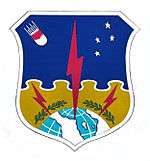
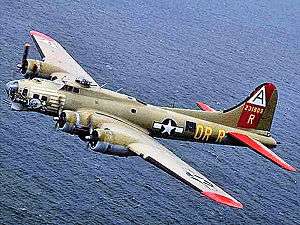
- Operated the B-17F/G Flying Fortress with "Triangle" tail codes between 22 February 1944 and 16 July 1945
- Headquartered at Brampton Grange, Brampton, Cambridgeshire
- 1st Combat Bombardment Wing, RAF Bassingbourn (Call sign: Goonchild/Swordfish)
- 91st Bombardment Group (Triangle-A), RAF Bassingbourn
- 381st Bombardment Group (Triangle-L), RAF Ridgewell
- 398th Bombardment Group (Triangle-W), RAF Nuthampstead
- 482d Bombardment Group (No Tail Code), (B-17, B-24) RAF Alconbury
- RADAR-equipped pathfinder group. Attached to: VIII Composite Command, 14 Feb 1944 – 1 Jan 1945
- 40th Combat Bombardment Wing, RAF Thurleigh (Call sign: Bullpen/Foxhole)
- 92d Bombardment Group (Triangle-B), RAF Podington
- 305th Bombardment Group (Triangle-G), RAF Chelveston
- 306th Bombardment Group (Triangle-H), RAF Thurleigh
- 41st Combat Bombardment Wing, RAF Molesworth (Call sign: Fatgal/Cowboy)
- 303d Bombardment Group (Triangle-C), RAF Molesworth
- 379th Bombardment Group (Triangle-K), RAF Kimbolton
- 384th Bombardment Group (Triangle-P), RAF Grafton Underwood
- 94th Combat Bombardment Wing, RAF Polebrook (Call sign: Ragweed/Woodcraft)
- 351st Bombardment Group (Triangle-J), RAF Polebrook
- 401st Bombardment Group (Triangle-S), RAF Deenethorpe
- 457th Bombardment Group (Triangle-U), RAF Glatton
- 67th Fighter Wing, Walcot Hall, Northamptonshire (Attached from VIII Fighter Command) (P-51D/K Mustang) (Call sign: Mohair)


- Operated B-24D/H/J/L/M Liberator with "Circle" tail codes until early February, 1944. Later designation was by various color vertical tail fins with contrasting horizontal, vertical, or diagonal stripes designating a specific bomb group between 22 February 1944 and 25 June 1945
- Headquartered at Ketteringham Hall[8] Norwich, Norfolk
- 2d Combat Bombardment Wing, RAF Hethel (Call sign: Winston/Bourbon)
- 389th Bombardment Group (Circle-C, Black/White Vertical ), RAF Hethel
- 445th Bombardment Group (Circle-F, Black/White Horizontal[9]), RAF Tibenham
- 453d Bombardment Group (Circle-J, Black/White Diagonal), RAF Old Buckenham
- 14th Combat Bombardment Wing, RAF Shipdham (Call sign: Hambone/Hardtack)
- 44th Bombardment Group (Circle-A), RAF Shipdham
- 392d Bombardment Group (Circle-D), RAF Wendling
- 491st Bombardment Group (Circle-Z), RAF North Pickenham (Aug 1944 – 16 Jul 1945)
- 492d Bombardment Group (Circle-U), RAF Harrington
- 20th Combat Bombardment Wing, RAF Hardwick (Call sign: Pinestreet/Bigbear)
- 93d Bombardment Group (Circle-B), RAF Hardwick
- 446th Bombardment Group (Circle-H), RAF Bungay
- 448th Bombardment Group (Circle-I), RAF Seething
- 489th Bombardment Group (Circle-W), RAF Halesworth (Aug 1944 – 16 Jul 1945)
- 95th Combat Bombardment Wing, RAF Halesworth (May–Aug 1944) (Call sign: Shamrock)
- 489th Bombardment Group (Circle-W), RAF Halesworth
- 491st Bombardment Group (Circle-Z), RAF North Pickenham
- 96th Combat Bombardment Wing, RAF Horsham St Faith (Call sign: Redstar/Lincoln)
- 458th Bombardment Group (Circle-K), RAF Horsham St. Faith
- 466th Bombardment Group (Circle-L), RAF Attlebridge
- 467th Bombardment Group (Circle-P), RAF Rackheath
- 65th Fighter Wing (Attached from VIII Fighter Command), Saffron Walden (P-51D/K Mustang) (Call sign: Colgate)


.
- Operated B-17F/G Flying Fortress with Square tail codes between 22 February 1944 and 16 July 1945
- Headquartered at RAF Honington, Thetford, Norfolk
- 4th Combat Bombardment Wing, RAF Bury St Edmunds (Call sign: Franklin/Hotshot)
- Redesignated from: 92d Combat Bombardment Wing, 22 November 1944
- Redesignated from: 4th Bombardment Wing (Provisional), 16 February 1945
- 94th Bombardment Group (Square-A), RAF Bury St. Edmunds
- 447th Bombardment Group (Square-K), RAF Rattlesden
- 486th Bombardment Group (Square-O/W), RAF Sudbury
- (Converted from B-24s to B-17s, Summer 1944)
- 487th Bombardment Group (Square-P), RAF Lavenham
- (Converted from B-24s to B-17s, Summer 1944)
- 13th Combat Bombardment Wing, RAF Horham (Call sign: Zootsuit/Fireball)
- 95th Bombardment Group (Square-B), RAF Horham
- 100th Bombardment Group (Square-D), RAF Thorpe Abbotts
- 390th Bombardment Group (Square-J), RAF Framlingham
- 45th Combat Bombardment Wing, RAF Snetterton Heath (Call sign: Zootsuit/Fireball)
- 96th Bombardment Group (Square-C), RAF Snetterton Heath
- 388th Bombardment Group (Square-H), RAF Knettishall
- 452d Bombardment Group (Square-L), RAF Deopham Green
- 93d Combat Bombardment Wing, RAF Mendlesham, (Call sign: Zootsuit/Fireball)
- 34th Bombardment Group (Square-S), RAF Mendlesham
- (Converted from B-24s to B-17s, Summer 1944)
- 385th Bombardment Group (Square-G), RAF Great Ashfield
- 490th Bombardment Group (Square-T), RAF Eye
- (Converted from B-24s to B-17s, Summer 1944)
- 493d Bombardment Group (Square-S), RAF Little Walden
- (Converted from B-24s to B-17s, Summer 1944)
- 34th Bombardment Group (Square-S), RAF Mendlesham
- 66th Fighter Wing, Sawston Hall, (Attached from VIII Fighter Command) (P-51D/K Mustang) (Call sign: Oilskin)
- Special Groups: as of 1 Jan 1945
- 36th Bombardment Squadron, (B-24H/J)
- Radar/Electronic-countermeasure operations: August 1944 – April 1945
Divisions (Strategic Air Command)
|
|
Wings
- 2d Bomb Wing, 16 Jun 1988 – present
- 5th Bomb Wing, 1 Jun 1991 – present
- 7th Bomb Wing, 1 Oct 2015 – present
- 9th Reconnaissance Wing, 1 Oct 2002 – 1 October 2009
- 28th Bomb Wing, 1 Oct 2015 – present
- 67th Information Operations (later, 67th Network Warfare) Wing, 1 Feb 2001 – present
- 509th Bombardment (later, 509th Bomb) Wing, 29 Mar 1989 – present
- 552d Air Control Wing, 1 Oct 2002 – 1 Oct 2009[10]
Groups
- 492d Bombardment Group, RAF North Pickenham, 18 Apr 1944 – 8 Jul 1945
- Assigned directly to Eighth Air Force Headquarters, performed special operations (Operation Carpetbagger) missions.
Centers
- 608th Air Operations Center (formerly 608th Air Operations Group and 608th Air and Space Operations Center), 1 Jan 1994 – present
- Air Force Information Operations: 1 May 2007 – present
Stations
|
|
See also
- Target for Today - ninety-four-minute depiction of an Operation Pointblank mission from 1944.
- Mighty Eighth Air Force Museum
- Eighth Air Force Museum
- David Wade, past commander
References
- ↑ The Eighth Air Force's now commonly-accepted nickname, "The Mighty Eighth", derives from the title of British farmer and life-long Eighth Air Force historian Roger A. Freeman's seminal History of the U.S. 8th Army Air Force (Doubleday and Company, 1970).
- ↑ Video: Allies Pierce Siegfried Line. Universal Newsreel. 1945. Retrieved February 21, 2012.
- ↑ "Factsheets : Eighth Air Force". 8af.af.mil. Archived from the original on 3 March 2016. Retrieved 2012-08-13.
- ↑ USAAF.net
- ↑ "Combat Chronology of the US Army Air Forces - May 1944". usaaf.net. Retrieved November 13, 2012.
- 1 2 3 USAF Historical Research Agency Document 00219137
- ↑ http://www.af.mil/News/ArticleDisplay/tabid/223/Article/968759/e-4bs-realign-under-8th-air-force-595th-cacg-stands-up.aspx
- ↑ "Headquarters". 2nd Air Division Memorial Library. Archived from the original on 18 September 2016. Retrieved 18 September 2016.
- ↑ Simpson, Michael. "History of the 445th Bomb Group, Revised Edition". Unit Historian. Self. Retrieved 29 May 2011.
- ↑ Blacke, Kinder (1 October 2009). "12 AF welcomes back 552 ACW". 552nd Air Control Wing Public Affairs. Archived from the original on 22 July 2011. Retrieved 18 September 2016.
- Maurer, Maurer (1983). Air Force Combat Units Of World War II. Maxwell AFB, Alabama: Office of Air Force History. ISBN 0-89201-092-4.
- Ravenstein, Charles A. (1984). Air Force Combat Wings Lineage and Honors Histories 1947–1977. Maxwell AFB, Alabama: Office of Air Force History. ISBN 0-912799-12-9.
![]() This article incorporates public domain material from the United States Government document "http://www.barksdale.af.mil/8af".
This article incorporates public domain material from the United States Government document "http://www.barksdale.af.mil/8af".
Bibliography
- Anderson, Christopher J. The Men of the Mighty Eighth: The U.S. 8th Air Force, 1942–1945 (G.I. Series N°24). London : Greenhill, 2001.
- Astor, Gerald. The Mighty Eighth: The Air War in Europe as told by the Men who Fought it. New York: D.I. Fine Books, 1997.
- Bowman, Martin. 8th Air Force at War: Memories and Missions, England, 1942–1945. Cambridge, UK: Patrick Stephens Ltd., 1994.
- Bowman, Martin. Castles in the Air: The Story of the Men from the US 8th Air Force. Walton-on-Thames, UK: Red Kite, 2000.
- Maurer, Maurer. Air Force Combat Units Of World War II. Office of Air Force History, 1961, republished 1983.
- Freeman, Roger A. and Winston G. Ramsey. Airfields of the Eighth: Then and Now. London: After the Battle, 1978. Republished 1992.
- Freeman, Roger A. The Mighty Eighth: Units, Men and Machines – A History of the US 8th Air Force. 1970. ISBN 0-87938-638-X.
- Revised as The Mighty Eighth: a History of the Units, Men and Machines of the Us 8th Air Force. Cassell & Co., 2000. ISBN 1-85409-035-6.
- Freeman, Roger A. et al. The Mighty Eighth War Diary. London: Jane's Publishing Company, 1981.
- Freeman, Roger A. (Ed.) The Mighty Eighth in Art. London: Arms & Armour, 1995.
- Freeman, Roger A. The Mighty Eighth in Colour. London: Arms & Armour, 1991.
- New Edition as The Mighty Eighth: The Colour Record. London: Cassell & Co., 2001.
- Freeman, Roger A. The Mighty Eighth War Diary. 1990. ISBN 0-87938-495-6.
- Freeman, Roger A. Mighty Eighth War Manual. London: Jane's Publishing Company, 1984.
- Freeman, Roger A. The Mighty Eighth: Warpaint and Heraldry. London: Arms & Armour, 1997.
- Lambert, John W. The 8th Air Force: Victory and Sacrifice: A World War II Photo History. Atglen, Pennsylvania: Schiffer Publishing, 2006. ISBN 0-7643-2534-5.
- McLachlan, Ian and Russell J. Zorn. Eighth Air Force Bomber Stories: Eye-Witness Accounts from American Airmen and British Civilians of the Perils of War. Yeovil, UK: Patrick Stephens Ltd., 1991.
- McLaughlin, (Brigadier General) J. Kemp. The Mighty Eighth in World War II: A Memoir. Kentucky University Press, 2000.
- Miller, Kent D. Fighter Units & Pilots of the 8th Air Force September 1942 – May 1945. Volume 1 Day-to-Day Operations – Fighter Group Histories. Atglen, Pennsylvania: Schiffer Publishing, 2000. ISBN 0-7643-1241-3.
- Miller, Kent D. and Nancy Thomas. Fighter Units & Pilots of the 8th Air Force September 1942 – May 1945. Volume 2 Aerial Victories – Ace Data. Atglen, Pennsylvania: Schiffer Publishing, 2001. ISBN 0-7643-1242-1.
- Ramsey, Winston G. [Editor]. Airfields of the Eighth. London: 1978.
- Scutts, Jerry. Lion in the Sky: US 8th Air Force Fighter Operations, 1942–1945. Cambridge, UK: Patrick Stephens Ltd., 1987.
- Smith, Graham. The Mighty Eighth in the Second World War. Newbury: Countryside Books, 2001.
- Steijger, Cees. A History of USAFE. Voyageur, 1991. ISBN 1-85310-075-7.
- Strong, Russell A. A Biographical Directory of the 8th Air Force, 1942–1945. Manhattan, Kansas: Military Affairs – Aerospace Historian, 1985.
- Werrell, Kenneth P. & Robin Higham. Eighth Air Force Bibliography : An Extended Essay & Listing of Published & Unpublished Materials. Manhattan, Kansas: Military Affairs – Aerospace Historian, 1981 (Second Edition 1997, Strasburg, Pennsylvania: 8th Air Force Memorial Museum Foundation, 1997).
- Woolnough, John H. (Ed.) The 8th Air Force Album: The Story of the Mighty Eighth Air Force in WW II. Hollywood, Florida: 8th AF News, 1978.
- Woolnough, John H. (Ed.) The 8th Air Force Yearbook: The current Status of 8th AF Unit Associations, 1980. Hollywood, Florida: 8th AF News, 1981.
- Woolnough, John H. (Ed.) Stories of the Eighth: An Anthology of the 8th Air Force in World War Two. Hollywood, Fla.: 8th AF News, 1983.
- Office of Air Force History (1983) [1961]. Maurer, Maurer, ed. Air Force Combat Units of World War II (PDF). Washington, D.C.: U.S. Govt. Print. Off. ISBN 0-912799-02-1. Retrieved 4 October 2007.
- "8th Air Force to become new cyber command". Archived from the original on 15 March 2007.
External links
- USAF Fact Sheets: Eighth Air Force History
- Eighth Air Force official website
- Eighth Air Force Archive at Penn State
- Eight Air Force tactical mission report of Operation Shuttle
- Establishment of the Eighth Air Force in the United Kingdom
- The Ruhr – one of the main target of the 8th USAAF in Europe, 1943–1945
- Map of 8th Air Force airfields in England 1942–1945
- Crew 21 – 96BG 337BS 1943 East Anglia, UK.
- Eighth Air Force Historical Society
- A 1956 LIFE photo of every plane in the Eighth Air Force's arsenal
- Eighth Air Force is available for free download at the Internet Archive
- 4th Fighter Group Association, 65 Fighter Wing, 8th Air Force World War II
- Replica WWII 8th AF Briefing Room at U.S. Veterans Memorial Museum
- National Museum of the Mighty Eighth Air Force Savannah, Georgia

